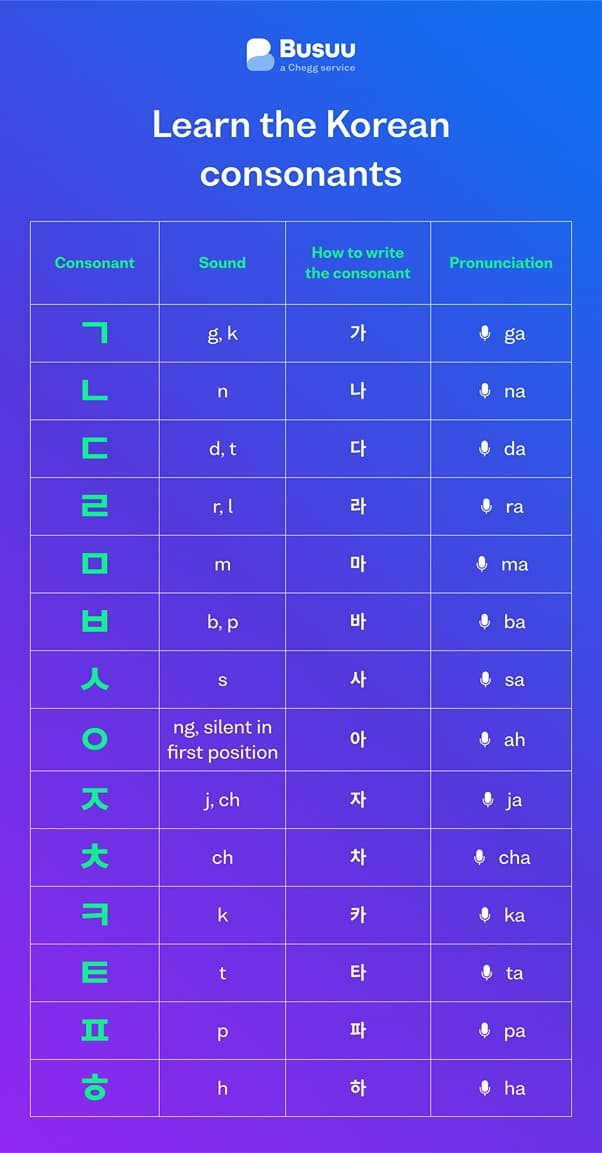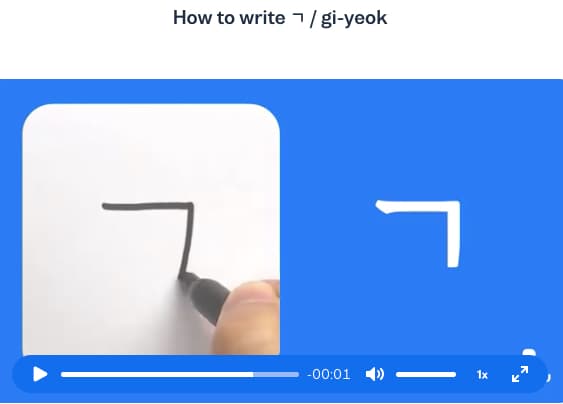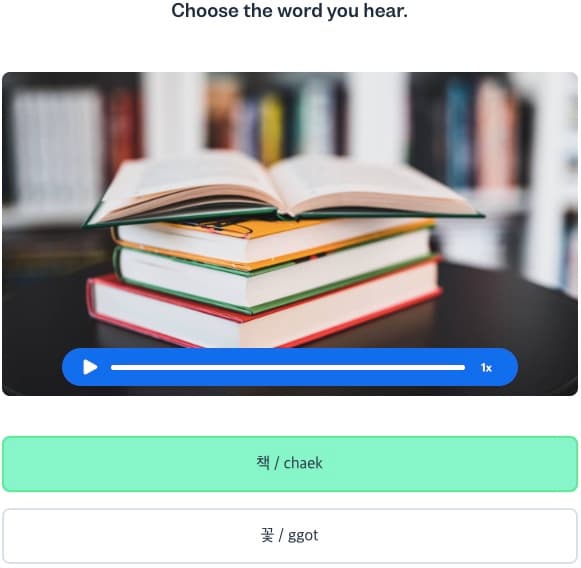I want to learn...
So, you want to learn the Korean alphabet. But you step back, thinking that it is one of the hardest languages to learn. It has characters that look like a bunch of boxes and circles that confuse you.
Fear not! You can learn this 500-year-old alphabet system in less than a day. And once you start, you’ll be on a roll.
This article will teach you the unique history of the Korean alphabet. It will show you how to get started with pronouncing Korean vowels and consonants. You will even make some words.
First, let’s get some context.
What is the Korean alphabet?
The Korean language is one of the oldest languages in the world. The alphabet, also calledhangeul(hangul), 한글, dates back to 1443 CE, when King Sejong the Great devised the writing system. He did so, so that the ordinary people of Korea, then called Joseon, could have a way of reading and writing.
Beforehangeul, only educated nobles were taught reading and writing using Chinese characters. King Sejong documented the new Korean alphabet in the manuscriptHunminjeongeum(훈민정음), as a way to equalize the playing field for most people in the land.
Is learning the Korean alphabet easy?
Aside from its historical creation by a monarch,hangeulis also one of the most logical alphabets on the planet. The way the consonants mimic movements of the tongue when making the sound is just one example of how much thought was put behind the creation of this alphabet.
The more you learn, the more sense it makes.
There are only 24 letters in the Korean alphabet: 14 consonants and 10 vowels. The consonants and vowels are combined together to sound out words, just like they are in English.
Once you learn the look and sound of the basic letters, you can make more complex letters.
Ready? Let’s start learning the alphabet in Korean.
Pro tip: Throughout the article, you’ll see some Korean words. Try writing them down to practice the strokes. Just like when writing letters in English, start from the top-left to the bottom-right.
Learn the Korean consonants
Let’s start learning the consonants in the Korean alphabet!
There are 14 consonants inhangeul. Some can be doubled to form another sound, but that’s a lesson for another day.
While similar to consonants in English, certain English sounds do not exist in Korean. This is the case for mostv, x, z, and thsounds. These are created similarly through other consonants. For example, z becomesji지and V becomesbeui브이. Those are just some examples of how English letters match in Korean.
One more thing! When saying the Korean alphabet, we add the vowelaㅏto sound out the letter. It’s much more memorable than saying “guh, nuh, tuh”, that’s for sure!
Study the consonants below and practice writing!

Table of Korean consonants
| Consonant | Sound | How to write the consonant | Pronunciation |
|---|---|---|---|
| ㄱ | g, k | 가 | ga |
| ㄴ | n | 나 | na |
| ㄷ | d, t | 다 | da |
| ㄹ | r, l | 라 | ra |
| ㅁ | m | 마 | ma |
| ㅂ | b, p | 바 | ba |
| ㅅ | s | 사 | sa |
| ㅇ | ng, silent in first position | 아 | ah |
| ㅈ | j, ch | 자 | ja |
| ㅊ | ch | 차 | cha |
| ㅋ | k | 카 | ka |
| ㅌ | t | 타 | ta |
| ㅍ | p | 파 | pa |
| ㅎ | h | 하 | ha |
Learn the Korean vowels
There are 10 Korean vowels. Some exist in English; some are a bit different. When practicing your Korean pronunciation, try enunciating, or exaggerating your mouth movements. This will make the sounds to come out clearer.
When pronouncing the plain vowel, pair it with the consonant ㅇ. It acts as a silent filler when used in front of vowels.
Study the vowels below and practice writing!

Table of Korean vowels
| Vowel | Sound | Example | How to write the vowel |
|---|---|---|---|
| ㅏ | a | ant | 아 |
| ㅑ | ya | yard | 야 |
| ㅓ | eo | cup | 어 |
| ㅕ | yeo | yearn | 여 |
| ㅗ | o | coal | 오 |
| ㅛ | yo | yogurt | 요 |
| ㅜ | oo | moo | 우 |
| ㅠ | yoo | you | 유 |
| ㅡ | eu | reason | 으 |
| ㅣ | i | hit | 이 |
Additionally to the 10 basic vowels, there are 11 complex vowels you can create by combining two basic vowels. It’s like adding o and u to make the “ow” sound. Here is a chart of how complex Korean vowels are formed and how to pronounce them.
Study the vowels below! Practice writing them too!
Complex Korean vowels
| Vowel | Sound | Example | Combination | How to write the vowel |
|---|---|---|---|---|
| ㅐ | e | egg | ㅏ + ㅣ | 애 |
| ㅔ | ae | egg | ㅓ + ㅣ | 에 |
| ㅒ | ye | yes | ㅑ + ㅣ | 얘 |
| ㅖ | yae | yeti | ㅕ + ㅣ | 예 |
| ㅘ | wa | Waikiki | ㅗ + ㅏ | 와 |
| ㅙ | wae | wet | ㅗ + ㅐ | 왜 |
| ㅞ | we | well | ㅜ + ㅔ | 웨 |
| ㅚ | oe | wedding | ㅗ + ㅣ | 외 |
| ㅝ | wo | women | ㅜ + ㅓ | 워 |
| ㅟ | wee | wee! | ㅜ + ㅣ | 위 |
| ㅢ | ui | - | ㅡ + ㅣ | 의 |
You might notice that 애 and 에 are represented in different roman alphabet letters. Both sound like “eh” and 왜, 웨, 외 are also the same sound of “we”!
In the past, it was important to differentiate the sounds of these vowels. In modern Korean, we pronounce them in the same way. Just remember to use the correct vowel when writing Korean, because gae개 means “dog” while ge 게 means “crab”!
How to read Korean letters
Korean syllables are formed by adding consonants and vowels together.
For example, the word,na나, or I, is formed by adding the consonantnㄴ with the vowelaㅏ.
ㄴ + ㅏ = 나
n + a = na
The noun particleneun, 는, is created by adding two consonantsnㄴwith the voweleuㅡ.
ㄴ + ㅡ + ㄴ = 는
n + eu + n = neun
You can use the same logic to spell out your name using Korean letters.
For example, Tom can be spelled as 톰.
ㅌ + ㅗ + ㅁ = 톰
T + o + m = Tom
And you’d spell his last name as 크루즈.
(ㅋ+ ㅡ) + (ㄹ + ㅜ) + (ㅈ + ㅡ) = 크루즈
크 + 루 + 즈 = 크루즈
C + ru + ise = Cruise
How to form Korean characters
Korean letters are all arranged in a box-like structure. You can combine letters together to make syllables, like you saw above.
There are three main structures when forming Korean characters.
1. Consonant + Vowel
ㅇ+ ㅗ + ㅐ = 왜 (wae)
ㄱ + ㅗ = 고 (go)
ㄴ + ㅏ = 나 (na)
2. Consonant + Vowel + Consonant
ㅌ + ㅗ + ㅁ = 톰 (Tom)
ㅇ + ㅣ + ㄹ = 일 (il)
3. Consonant + Vowel + Consonant + Consonant
ㅅ+ㅏ + ㄹ + ㅁ = 삶 (salm)
We’ll get to learning more complicated structures another time. At this stage, you should know that once you start learning the alphabet, you’ll be able to start spelling and reading right after!
Below is a chart of the Korean alphabet. It has all the basic consonant and vowel combinations.
Can you practice writing them all?
Note: Some combinations aren’t in use. They are highlighted in gray.
Korean Alphabet Chart
| vowel | ||||||||||
|---|---|---|---|---|---|---|---|---|---|---|
| consonant | ㅏ | ㅑ | ㅓ | ㅕ | ㅗ | ㅛ | ㅜ | ㅠ | ㅡ | ㅣ |
| ㄱ | 가 | 갸 | 거 | 겨 | 고 | 교 | 구 | 규 | 그 | 기 |
| ㄴ | 나 | 냐 | 너 | 녀 | 노 | 뇨 | 누 | 뉴 | 느 | 니 |
| ㄷ | 다 | 댜 | 더 | 뎌 | 도 | 됴 | 두 | 듀 | 드 | 디 |
| ㄹ | 라 | 랴 | 러 | 려 | 로 | 료 | 루 | 류 | 르 | 리 |
| ㅁ | 마 | 먀 | 머 | 며 | 모 | 묘 | 무 | 뮤 | 므 | 미 |
| ㅂ | 바 | 뱌 | 버 | 벼 | 보 | 뵤 | 부 | 뷰 | 브 | 비 |
| ㅅ | 사 | 샤 | 서 | 셔 | 소 | 쇼 | 수 | 슈 | 스 | 시 |
| ㅇ | 아 | 야 | 어 | 여 | 오 | 요 | 우 | 유 | 으 | 이 |
| ㅈ | 자 | 쟈 | 저 | 져 | 조 | 죠 | 주 | 쥬 | 즈 | 지 |
| ㅊ | 차 | 챠 | 처 | 쳐 | 초 | 쵸 | 추 | 츄 | 츠 | 치 |
| ㅋ | 카 | 캬 | 커 | 켜 | 코 | 쿄 | 쿠 | 큐 | 크 | 키 |
| ㅌ | 타 | 탸 | 터 | 텨 | 토 | 툐 | 투 | 튜 | 트 | 티 |
| ㅍ | 파 | 퍄 | 퍼 | 펴 | 포 | 표 | 푸 | 퓨 | 프 | 피 |
| ㅎ | 하 | 햐 | 허 | 혀 | 호 | 효 | 후 | 휴 | 흐 | 히 |
And that’s it! That’s the Korean alphabet, 한글, from A to Z, or shall we say,gatoha? It’s time to get out there and cut your teeth on some basic Korean phrases.
Newlanguages


